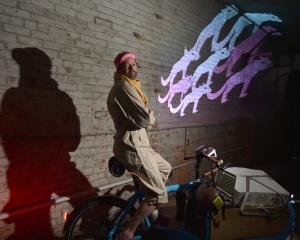Masks have been part of Indian Ink's productions since its inception and its latest production Kiss the Fish is no exception. Rebecca Fox asks what influence masks have on a theatre production.
A magical transformation occurs when an actor puts on a mask, Indian Ink's Jacob Rajan says.
''To this day when one of the actors takes his mask off I'm surprised to see the real person underneath. The character is so totally tied up with the mask that when they remove the mask the character is gone,'' actor and writer Mr Rajan said.
''That's magical, a real transformation.''
Indian Ink's latest production Kiss the Fish, with its wardrobe of Balinese masks, finally arrives in Dunedin next week.
Mr Rajan and director Justin Lewis sourced the masks from a Balinese carver they had studied with. They had also studied an Italian mask tradition, discovering surprising links between the two.
''It's uncanny how similar some of the characters are,'' Mr Rajan said.
In the nearly 20 years the company, which had been founded on a love of masks, had been operating it had accumulated a huge number of masks but members had been ''itching'' to use the Balinese ones for some time.
''It [masks] was something I was introduced to even prior to drama school. I adored them.
''But I never saw them used on the main stage; they're relegated to children's theatre or street theatre.''
In Kiss the Fish, the masks enable the small troupe of four actors to form the characters of a village facing a crisis, particularly one family.
''It's a love story within a family, three generations tussling with the whole thing of the old world meeting the new world.''
Masks were an incredibly powerful and theatrical form, as they did not really work on film or television, he said.
''More and more the theatre I saw was trying to imitate film and television and I found that really dissatisfying.''
Essential to masks working was audience interaction and the connection with the audience, Mr Rajan said.
''We are all just people in a cave listening to a story.''
Maybe that was why the play worked and had been so successful. Last year it was named best new play of the year, and was judged to have the best composer and best supporting actress in the Chapman Tripp Theatre Awards.
''Everyone understands the characters of the village - the miser, the priest, the masters and servants - they are typical throughout all societies.
''People are people and they're the same everywhere.''
Humour was also a big part of using masks as they were a large part of comic tradition, he said.
''They're just delightful characters.''
Acting with masks required not only the audience's imagination but also for the actors to use their bodies and voices much more to convey emotion.
''Actually the funny thing about masks is there is a three-step process. You are laughing at them because they're quite cartoony and larger than life and then you're laughing with them and by the end you're loving them.
''They feel like real people.''
Actress Nisha Madhan (Show Pony, Shortland Street, Blue Rose) joined the cast nearly three years ago to play the love interest of the main character and had toured with the production around the United States and New Zealand.
''It's only taken us three years to get to Dunedin.''
She found working in masks to be ''easier somehow'' than without.
''You are putting a different face on. As soon as you put it on you can delve into the character, instantly transforming yourself into them.''
It demanded walking and talking in certain ways to get across the character.
''It can be very physical.''
Working with Indian Ink was something Ms Madhan had wanted to do for a long time, having first seen one of the company's early productions Krishna's Dairy when she was 16 years old.
''It's a dream come true. It only took them a decade to find me.''
In the past few years she had laughed more in rehearsal than she ''had done in my entire life''.
Mr Rajan agreed the work could be quite tough.
His character alone had 26 costume changes. So for that to seem quite seamless to the audience took quite a lot of choreography and work, he said.
''The audience would never know what the insanity is backstage.''
The company's stage manager is the tour manager and lighting manager as well, so the actors all did their own costume changes.
Masks also enabled the small cast to take on many characters, he said.
''You can almost hear an audible gasp when we come out for a curtain call, when there is only four of us and a musician on stage yet they've seen the whole village.''
''It's a bit like a magic trick''The cumulative effect at the end of the show was a real warmth and feel-good feeling, he said.
''And a tinge of sadness, it's very real and quite surprising. The audience goes from ridiculous hilarity and belly-laughs to something deep and profound.''
It had been a long time since Mr Rajan had visited Dunedin - he had performed in one of the city's early arts festivals - but he was looking forward to it.
''We're bringing a bit of sunshine, as the play is set on a tropical island.''
The company was already workshopping a new show, preparing for a tour of the US in October and readying themselves for a feature film next year.
''It is an international company now.''












![... we all become all of these things [installation view] (2025), by Megan Brady.](https://www.odt.co.nz/sites/default/files/styles/odt_landscape_small_related_stories/public/story/2025/03/1_we_all_become_all_of_thes.jpg?itok=nicA_yAm)